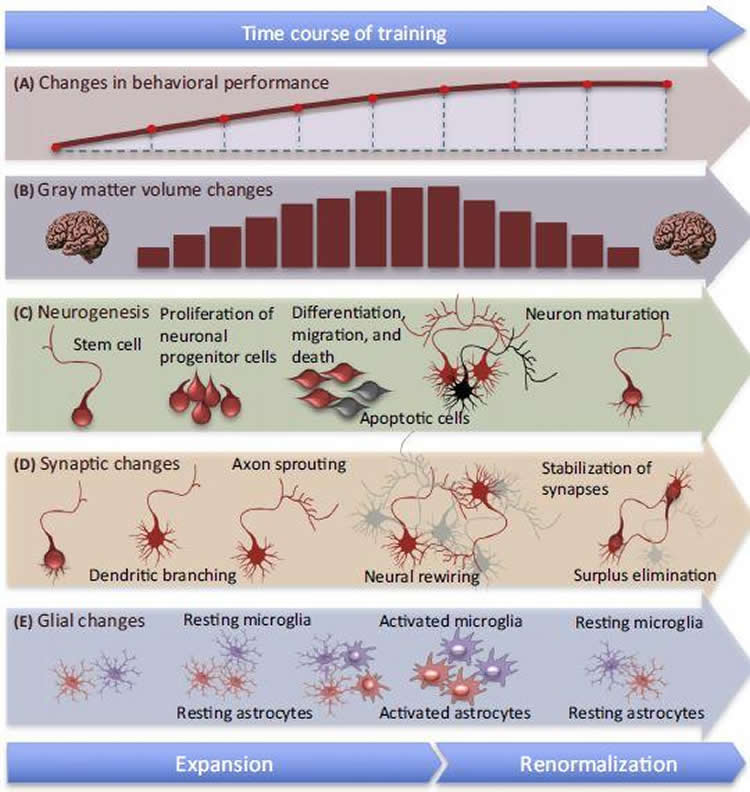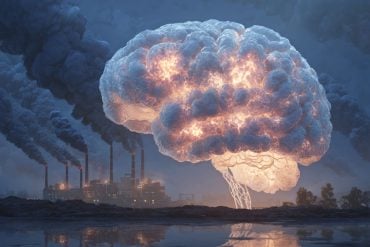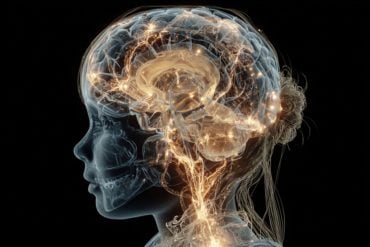Summary: Brain cells initially increase as we learn new things, but many are either pruned or reused in other roles over time, a new study reports.
Source: Cell Press.
For decades, neuroscientists have wondered how the brain can continue to learn new skills without needing to grow in size or volume over a person’s lifetime. Evidence suggests that the number of brain cells – such as neurons and glial cells – does initially increase as we’re learning, but many are eventually pruned away or assigned to other roles. Researchers in Germany and Sweden present this theory November 14 in the review journal Trends in Cognitive Sciences.
“Brain matter volume increases in the initial stages of learning, and then renormalizes partially or completely,” says first author Elisabeth Wenger, a neuroscientist at the Max Planck Institute for Human Development in Berlin. “This seems to be an effective way for the brain to first explore the possibilities, call in different structures and cell types, select the best ones, and get rid of the ones that are no longer needed.”
She describes brain cells as actors auditioning for a movie for which the brain is the director: The brain calls in the candidates by forming new cells, and this causes it to grow macroscopically in volume. The brain then tries out different functions for them–seeing which can store or carry the information best. Based on which cells function most efficiently, the brain dismisses the other candidates or assigns them to different roles.
As evidence, the researchers discuss a study in which right-handed people learned to write and draw with their left hands. After a month, their brain volume had increased, but three weeks later it was nearly back to normal. Researchers observed similar results in other studies in which monkeys learned to use a rake to retrieve food or rats learned to differentiate between sounds.

Wenger and her co-authors, including Claudio Brozzoli, Ulman Lindenberger, and Martin Lövdén, were surprised by how often the phenomenon of brain expansion and renormalization has been recorded already in animal studies, and predict it applies to human brains too. “We are definitely not the first to suggest or introduce the expansion-renormalization model,” says Wenger. “I think we are just the ones who are now promoting it in the field of grey matter volume changes in humans.”
The researchers believe that this theory should influence how researchers design neural studies. “In a way, it is now apparent that the typical design is just insufficient to show the full scope of changes that happen,” Wenger says. “This theory calls for study designs with more measurement time points to properly display changes in brain volume.”
Funding: This work was supported by the Max Planck Society, European Research Council, the Swedish Research Council, the European University Institute, and the Agence Nationale de la Reserche.
Source: Cara Cavanaugh – Cell Press
Publisher: Organized by NeuroscienceNews.com.
Image Source: NeuroscienceNews.com image is credited to Wenger et al./Trends in Cognitive Sciences 2017.
Original Research: Full open access research for “Expansion and Renormalization of Human Brain Structure During Skill Acquisition” by Elisabeth Wenger, Claudio Brozzoli, Ulman Lindenberger, and Martin Lövdén in Trends in Cognitive Sciences. Published online November 2017 doi:10.1016/j.tics.2017.09.008
[cbtabs][cbtab title=”MLA”]Cell Press “Brain Auditions Different Cells When Learning a Task, Some Don’t Make the Cut.” NeuroscienceNews. NeuroscienceNews, 14 November 2017.
<https://neurosciencenews.com/neurons-task-learning-7944/>.[/cbtab][cbtab title=”APA”]Cell Press (2017, November 14). Brain Auditions Different Cells When Learning a Task, Some Don’t Make the Cut. NeuroscienceNews. Retrieved November 14, 2017 from https://neurosciencenews.com/neurons-task-learning-7944/[/cbtab][cbtab title=”Chicago”]Cell Press “Brain Auditions Different Cells When Learning a Task, Some Don’t Make the Cut.” https://neurosciencenews.com/neurons-task-learning-7944/ (accessed November 14, 2017).[/cbtab][/cbtabs]
Abstract
Expansion and Renormalization of Human Brain Structure During Skill Acquisition
Research on human brain changes during skill acquisition has revealed brain volume expansion in task-relevant areas. However, the large number of skills that humans acquire during ontogeny militates against plasticity as a perpetual process of volume growth. Building on animal models and available theories, we promote the expansion–renormalization model for plastic changes in humans. The model predicts an initial increase of gray matter structure, potentially reflecting growth of neural resources like neurons, synapses, and glial cells, which is followed by a selection process operating on this new tissue leading to a complete or partial return to baseline of the overall volume after selection has ended. The model sheds new light on available evidence and current debates and fosters the search for mechanistic explanations.
Trends
Research on human plasticity has been energized by the discovery of experience-dependent growth of brain volume in adulthood. However, is it really feasible to portray the vast amount of knowledge and the large number of skills that humans acquire in terms of a perpetual process of brain volume growth?
Prominent theoretical accounts of plasticity, developmental data, and animal models suggest a sequence of learning-related expansion, selection, and renormalization of brain activity and structure.
Recent studies on experience-dependent changes in gray matter structure also support this model for human learning. Estimates of the volume of human primary motor cortices were recently shown to increase during the first weeks of motor learning and then partially renormalize during continued practice.
“Expansion and Renormalization of Human Brain Structure During Skill Acquisition” by Elisabeth Wenger, Claudio Brozzoli, Ulman Lindenberger, and Martin Lövdén in Trends in Cognitive Sciences. Published online November 2017 doi:10.1016/j.tics.2017.09.008






